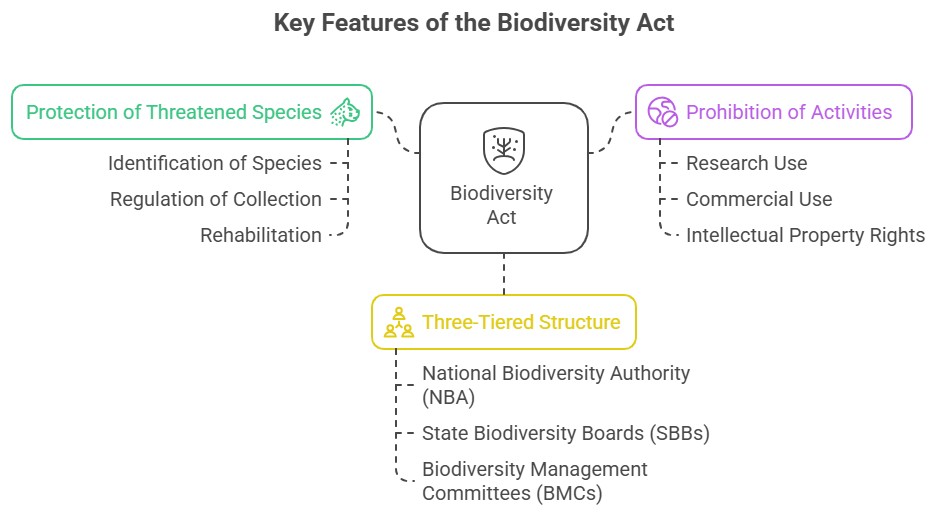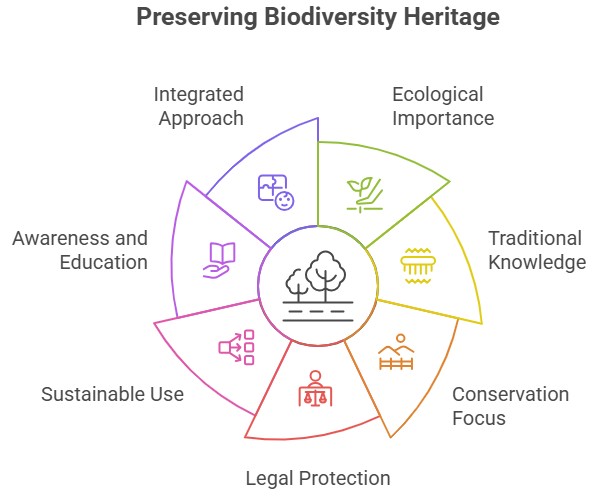India is one of the world’s most biodiverse countries, committed to preserving its rich ecological heritage through robust laws, national missions, and conservation programs. These initiatives aim to ensure sustainable use and protection of biodiversity.
1. National Guidelines, Legislations & Other Programmes related to Biodiversity Conservation
|
Key Initiatives Associated with Biodiversity Conservation in India
|
- National Biodiversity Action Plan (NBAP)
- Biological Diversity Act, 2002
- Biodiversity Heritage Sites (BHS) program
- National Wildlife Action Plan
- Wildlife Protection Act, 1972
- Indian Forest Act, 1927
- Forest (Conservation) Act, 1980
- Wetland (Conservation and Management) Rules, 2017
- National Wetland Conservation Program (NWCP)
- National Green India Mission (GIM)
- Project Tiger
- Project Elephant
|
- National Mission on Himalayan Studies (NMHS)
- National Mission for Sustaining the Himalayan Ecosystem (NMSHE)
- National Mission for a Green India (GIM)
- Integrated Development of Wildlife Habitats (IDWH)
- Coastal Regulation Zone (CRZ) Notification, 2019
- National Marine Turtle Action Plan
- National Plan for Conservation of Aquatic Ecosystems (NPCA)
- National Action Plan for Vulture Conservation in India
- National Mission on Sustainable Habitat
- National Mission on Biodiversity and Human Well-Being
|
2. The National Biodiversity Action Plan (NBAP)
India's National Biodiversity Action Plan (NBAP) is a comprehensive plan that seeks to protect, conserve, and augment biodiversity resources within the country.
Thematic Areas: The NBAP identifies several thematic areas of intervention including:
- Strengthening and integration of in-situ and ex-situ conservation measures.
- Regulation of the introduction of invasive alien species and their management.
- Integration of biodiversity concerns in economic and social development.
Integration of Biodiversity Concerns:
- Livelihood Security: The NBAP emphasizes that the conservation of biodiversity should lead to enhancement of livelihood security, poverty alleviation, and ensuring equitable sharing of benefits.
- Biodiversity Management Committees (BMCs): The NBAP proposes the strengthening of BMCs at the local level for conservation of biodiversity.
- The NBAP emphasizes public participation
- Research and Training: The NBAP encourages research in the area of biodiversity.
- International Cooperation:
- Strengthening the regulatory framework for biodiversity conservation.
- Monitoring and Evaluation: The NBAP has provisions for monitoring and evaluating the effectiveness of the measures taken for biodiversity conservation.
3. Biodiversity Act, 2002
The Biodiversity Act, of 2002 aims to regulate access to biological resources, protect traditional knowledge rights, and ensure equitable benefit sharing.
Key Features of the Act
Protection of Threatened Species and Repositories Designation:
- The Act empowers the Central Government, in consultation with the NBA, to identify threatened species and regulate their collection, rehabilitation, and conservation.
- Prohibition of activities: without prior approval from the National Biodiversity Authority. These activities include:
- Obtaining biological resources found in India for research or commercial use, whether by individuals or organizations, regardless of their location.
- Transferring the outcomes of research conducted on biological resources found in or obtained from India.
- Asserting any intellectual property rights over inventions based on research conducted on biological resources obtained from India.
- Envisions three-tiered structure:
- National Biodiversity Authority (NBA): The NBA is the central regulatory authority responsible for implementing the Act at the national level.
- State Biodiversity Boards (SBBs): SBBs are established in each state to implement the Act at the state level, regulating access and promoting biodiversity conservation.
- Biodiversity Management Committees (BMCs): BMCs at the local level facilitate biodiversity conservation, awareness, and implementation of related activities

Biodiversity Amendment Bill, 2021
The Biological Diversity (Amendment) Bill, 2021 was introduced in Lok Sabha in December 2021 and referred to a Joint Parliamentary Committee. The Bill seeks to amend the Biological Diversity Act, 2002 to encourage the Indian system of medicine and cultivation of wild medicinal plants, fast-track research, patent application, and transfer of research results, decriminalise offences, and encourage
Features of the Bill
- Domestic companies' compliance requirements are simplified by the Bill.
- Codified traditional knowledge and AYUSH practitioners won't have to share advantages with local populations.
- Research and bio-survey operations are exempt from benefit sharing obligations under the Bill.
- The user and the local management committee represented by the National Authority will agree on benefit-sharing conditions.
- All offenses are decriminalized.
- The Bill adds Nagoya Protocol references to the Act.
Issues with the Bill
- No definition exists for codified traditional knowledge.
- Benefit sharing may not apply to all local traditional knowledge.
- Inconsistent definition of foreign-controlled firm: A "foreign-controlled" firm "incorporated in India" must get NBA authorisation for certain actions, according to the Bill.
- The Bill defines a "foreign-controlled firm" as a foreign company under Section 2(42) of the Companies Act, 2013, controlled by a foreigner.
- Section 2(42) of the Companies Act defines a foreign company as a company or body corporate incorporated outside India.
- the Bill contradicts itself by seeking NBA clearance for a company incorporated in India (Clause 5) yet incorporated outside India (Section 2(42) of the Companies Act).
- Local communities no longer determine benefit-sharing provisions under the Bill.
- Instead of criminalizing Act offenses, the Bill imposes a variety of sanctions. Additionally, the Law authorizes government inquiries and fines.
- It's debatable whether government personnel should have such discretion.
Measures Needed
- Conserving Biological Resources: The JPC suggested empowering biodiversity management committees under the proposed law and indigenous communities by clearly designating benefit claimants as biological resource conservers.
- Cultivating medical plants reduces pressure on wild medicinal plants.
- Codified traditional knowledge should promote Indian medicine.
- Promoting indigenous research and Indian firms through fast-tracking research, patent applications, and research outcomes while using India's biological resources without breaching the International biodiversity convention.
- Promote Sustainable Use: Develop national biological resource conservation, promotion, and sustainable use strategies with the state government.
- Civil Offence: The committee also advised that any violation of the Biological Diversity Act, 2002 should result in civil penalties with corresponding fines to deter violators.
- Defining foreign companies as per the Companies Act and defining a protocol for Indian biological resource use are needed to attract more foreign investments in biological resource research, patent, and commercial use without compromising national interest.
- Exempt AYUSH Practitioners: The committee underlined that AYUSH practitioners who practice traditional medicine, including Indian systems of medicine, for sustenance and subsistence are exempt from prior intimation to state biodiversity boards to access biological resources.
|
Important terminologies
- The concept of ‘Deep Ecology’ believes in the intrinsic value of every living being, wherein all life is to be respected for its own sake, not for any of its monetary values.
|
Bioresources for Commercial Purposes
"Dabur accused of unauthorised commercial use of bioresources by National Biodiversity Board, informs NGT."
Introduction
- Definition: Bioresources refer to biological materials, organisms, and genetic resources derived from living organisms, which hold significant commercial value.
- Utilization: Bioresources can be utilised for various purposes, including medicine, agriculture, biotechnology, and industrial applications.
Components/Principles of Bioresources
- Genetic Diversity: Allows for the development of high-yielding, disease-resistant varieties, enhancing commercial productivity.
- Sustainable Harvesting: The sustainable management of fish stocks in commercial fisheries helps maintain their populations and ensures a continuous supply for the seafood industry.
- Conservation and Preservation: The conservation of coral reefs ensures the sustainability of marine bioresources.
Benefits of Bioresources for Commercial Purposes
- Economic Value: The global herbal medicine market, fuelled by the commercial demand for bioresources, is projected to reach $411 billion by 2026.
- Medicinal Applications: The anticoagulant drug heparin, derived from pig intestines, has significant commercial value in the pharmaceutical industry.
- Agricultural and Food Security: Genetically modified crops, such as Bt cotton, have revolutionized commercial agriculture by providing pest resistance and increased yields.
- Industrial Applications: Microorganisms like Escherichia coli and Saccharomyces cerevisiae are used in the commercial production of recombinant proteins and bioethanol, respectively.
Challenges and Threats
- Biodiversity Loss, Overexploitation of bio-resources, and issues related to Intellectual Property Rights:
|
Solutions:
- Sustainable Management Practices
- Legal and Policy Framework: The Nagoya Protocol provides guidelines for accessing and utilizing genetic resources,
- Research and Innovation:
- Example: The commercial success of genetically modified crops, such as herbicide-tolerant soybeans, is a result of research and innovation in agricultural biotechnology.
- Public Awareness and Education.
- Example: Consumer awareness of sustainably sourced palm oil has influenced commercial demand and encouraged the industry
|
Need and Potential:
- Sustainable Development: The commercial cultivation of sustainable palm oil, meeting global demand while ensuring forest conservation and community well-being.
- Climate Change Mitigation: The use of biomass for bioenergy production reduces reliance on fossil fuels, contributing to global efforts to reduce greenhouse gas emissions.
- Food Security: The conservation and utilization of crop wild relatives contribute to the development of climate-resilient and high-yielding crop varieties.
- Biodiversity Conservation: Eco-tourism centered around bioresource-rich areas promotes conservation efforts while providing income opportunities for local communities.
|
Conclusion
Globally, bioresources play a vital role in achieving sustainable development, climate change mitigation, food security, biodiversity conservation, and human health and well-being. Their responsible management, sustainable practices, knowledge sharing, and policy frameworks are crucial for unlocking their full potential. International collaboration, equitable.
|
Extra Marks Fetching component by theIAShub
Examples of bioresources:
- Medicinal Plants: Plants like ginseng, turmeric, and yew tree
- Marine Organisms: The oceans are a rich source of bioresources, including marine algae, fish
- Microorganisms: Bacteria, fungi
|
|
4. The National Mission on Biodiversity and Human Well-Being
The National Mission on Biodiversity and Human Well-Being is an initiative launched in 2018 that aims to prioritize biodiversity and conservation in Indian science, policy, and society. It is intended to be inclusive, involving scientific institutions, government agencies, non-government organizations, and people from various walks of life?1?.
Key points about the mission include
- It aims to help India realize the United Nation’s Sustainable Development Goals by using India’s rich biodiversity to create solutions for challenges in agriculture, health, and climate change?. The mission is designed to enhance biodiversity science?.
- The mission proposes a two-component program. The first component, titled the ‘Cataloguing and Mapping Life of India’ program, will focus on building an inventory of India’s biodiversity.
- The second component is divided into six programs, which will focus on biodiversity with regard to ecosystem services; climate change and disaster risk reduction; agriculture; health; bio-economy; and capacity building and outreach?.
|
One Health: Opportunities and Challenges
Introduction:
- One health is an integrated and collaborative approach that recognizes the interconnectedness of human health, animal health, and the health of the environment.
Opportunities and Challenges

Measures to achieve one health:
Policy Coordination and Governance: Establish coordinated policies and decentralized governance structures, such as at the panchayat level.
- Capacity Building and Research Innovation
- Integration of AI and Data Analysis: Utilize AI and data analysis techniques for efficient sample analysis,
- Leadership and Strategic Planning: Establish effective leadership mechanisms, foster cross-sector collaboration, and develop comprehensive strategies and action plans to ensure the long-term success and sustainability of One Health initiatives.
Conclusion: A multi-faceted approach involving collaboration among policymakers, researchers, healthcare professionals, veterinarians, environmentalists, and the public can pave the way for sustainable lives in the future.
|
5. Biodiversity Heritage Sites
Biodiversity Heritage Sites: Biodiversity Heritage Sites, defined by the Biodiversity Act of 2002, are areas of ecological significance that possess unique, rare, or endemic biodiversity. These sites are legally protected and recognized for their crucial role in conserving biological diversity.
Importance of BHS
- Ecological Importance: BHS are recognized for their unique biodiversity. These sites aim to preserve and protect Traditional Knowledge and Cultural Practices
- Examples:
- Medicinal Knowledge: Sacred Groves in Meghalaya and Vaidyars in Kerala represent such Forested areas which are protected on the basis of traditional beliefs,
- Indigenous Agriculture and Festivals: Indigenous agriculture in Arunachal Pradesh promotes biodiversity conservation,
- Conservation Focus: The main objective of designating BHS is the conservation and preservation of the rich biodiversity found within these sites.
- Legal Protection, Sustainable Use, Awareness and Education and Integrated Approach

6. National Wildlife Action Plan (2017-2031)
- The National Wildlife Action Plan is landscape-based, rather than being based on sanctuaries or national parks, with a focus on preserving genetic diversity and promoting sustainable development. The NWAP contains five components:
- Strengthening and promoting the integrated management of wildlife and their habitats.
- Adaptation to climate change and promoting integrated sustainable management of aquatic biodiversity in India.
- Promoting eco-tourism, nature education, and participatory management.
- Strengthening wildlife research and monitoring the development of human resources in wildlife conservation.
- Enabling policies and resources for the conservation of wildlife in India.














